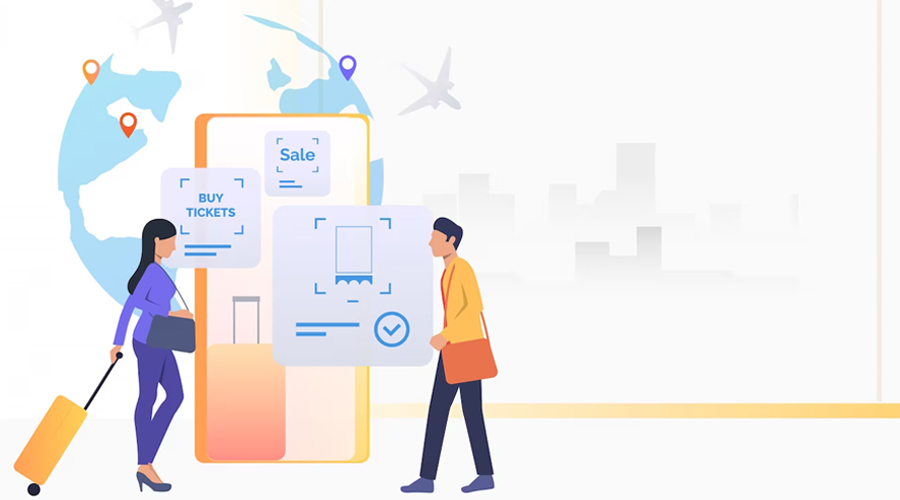Table of Contents
Introduction to Travel App Development
The allure of exploration and the quest for new experiences have been an intrinsic part of human nature for centuries. While the essence of travel remains timeless, the tools and technologies we employ to navigate our journeys have undergone a remarkable transformation. In this era of unprecedented digitalization, the travel landscape has been revolutionized by the advent of travel app development.
The Historical Tapestry of Travel:
Travel, in its earliest forms, was an arduous and perilous undertaking. Journeys that once took months are now compressed into mere hours. The emergence of railways, automobiles, and airplanes catapulted humanity into an era of rapid mobility. Yet, despite these advancements, the challenges of navigating foreign landscapes, understanding diverse cultures, and ensuring a seamless travel experience persisted.
Enter the digital age, where the convergence of smartphones, ubiquitous connectivity, and sophisticated software gave rise to travel apps. These applications became the modern-day compass, guiding travelers through the complexities of planning, navigating, and enjoying their sojourns. The evolution of travel app development is a testament to our collective commitment to enhancing the travel experience, making it more accessible, personalized, and technologically enriched.
The Advent of Travel Apps:
The dawn of the 21st century witnessed a paradigm shift in how people approached travel. The advent of smartphones brought a miniaturized universe of possibilities to our fingertips. Recognizing the potential of this handheld technology, developers began crafting applications specifically tailored for the travel domain. These apps aimed not only to streamline the logistics of travel but also to redefine the very essence of the journey.
Early travel apps were rudimentary, offering basic functionalities such as itinerary planning and simple booking options. However, the rapid pace of technological innovation spurred the integration of advanced features that would come to define the next generation of travel apps. Today, these applications are multifaceted, offering a comprehensive suite of tools that cater to the diverse needs of modern travelers.
The Significance of Travel App Development:
At the heart of the significance of travel app development lies its ability to democratize travel. What was once the privilege of a select few has become an accessible endeavor for individuals across the globe. The democratization of travel is not solely about affordability but extends to the empowerment of every traveler with the tools to make informed decisions, navigate unfamiliar terrain, and curate personalized experiences.
Travel apps have become indispensable companions, serving as virtual concierges that assist at every stage of the journey. From the initial spark of wanderlust to the triumphant return home, these apps are instrumental in shaping the travel narrative. The significance lies not only in their practical utility but also in their role as enablers of cultural exchange, fostering a global community of explorers connected by shared experiences.
Key Features of Travel Apps:
- User-Friendly Interface: The success of a travel app hinges on its ability to provide a seamless and intuitive user experience. Navigating through the app should be a frictionless journey, allowing users of varying technological proficiency to harness its full potential.
- Real-Time Updates: The dynamic nature of travel necessitates real-time information. Travel apps excel in delivering live updates on flight statuses, weather conditions, and traffic, ensuring that travelers remain informed and agile in their decision-making.
- Personalized Recommendations: Machine learning algorithms lie at the core of modern travel apps, analyzing user preferences, historical data, and behavioral patterns to offer bespoke recommendations. Whether it’s suggesting a quaint bed and breakfast or a hidden gem of a restaurant, these apps aim to tailor the travel experience to individual tastes.
- Offline Accessibility: Acknowledging that the journey may lead to areas with limited connectivity, travel apps now offer offline functionality. Users can download maps, itineraries, and essential information in advance, mitigating the impact of connectivity issues.
- Secure Payment Options: As transactions increasingly move into the digital realm, security becomes paramount. Travel apps integrate with secure payment gateways, ensuring that users can make reservations and payments with confidence, safeguarding their financial information.
The Impact on the Future of Travel:
As we gaze into the future, the trajectory of travel app development promises an even more transformative influence on the way we explore the world. Several trends are poised to shape the next phase of evolution:
- Augmented Reality (AR) Integration: The integration of AR technology is set to elevate the travel experience to new heights. Imagine strolling through ancient ruins with a virtual guide or receiving real-time translations of foreign signs through your smartphone’s camera. AR has the potential to provide an interactive and immersive layer to the travel narrative.
- Blockchain for Enhanced Security: Blockchain technology, known for its decentralized and secure nature, is poised to play a crucial role in fortifying the security of travel transactions. From securing personal data to enabling seamless and transparent transactions, blockchain has the potential to address cybersecurity concerns that often accompany digital transactions.
- Voice-Activated Assistance: Voice recognition technology is becoming increasingly sophisticated, paving the way for a hands-free interaction with travel apps. Travelers can expect to navigate through the app, receive updates, and make reservations using natural language commands. This not only enhances convenience but also addresses accessibility concerns, especially in situations where using a touchscreen may be impractical.
- Predictive Analytics for Hyper-Personalization: The next frontier for travel apps lies in predictive analytics. By analyzing vast datasets and understanding user behavior, these apps can anticipate preferences and proactively offer personalized suggestions. This level of hyper-personalization goes beyond recommendations; it extends to predicting travel trends, optimizing routes, and even suggesting ideal times for particular activities based on historical data.
Key Features of Successful Travel Apps
In the dynamic realm of travel app development, the success of an application hinges on its ability to provide a comprehensive, user-friendly, and innovative experience. As the demand for seamless travel solutions continues to rise, successful travel apps distinguish themselves by incorporating key features that address the diverse needs and preferences of modern travelers. This article delves into an in-depth exploration of these crucial features, shedding light on how they contribute to the success of travel apps in the competitive digital landscape.
- Intelligent Trip Planning:Successful travel apps stand out by offering intelligent trip planning features. These go beyond simple itinerary creation and incorporate advanced algorithms to suggest personalized travel plans based on user preferences, interests, and past travel history. By leveraging machine learning, these apps continuously refine their recommendations, ensuring that users receive tailored suggestions for accommodations, activities, and attractions.
- Real-Time Collaboration and Sharing:Facilitating group travel or sharing itineraries with friends and family is a key feature that enhances the social aspect of travel. Successful travel apps enable real-time collaboration, allowing users to share their travel plans, recommendations, and experiences with others. This fosters a sense of community and provides valuable insights for fellow travelers.
- Multilingual Support and Translation:Recognizing the global nature of travel, successful apps integrate robust multilingual support and translation features. These tools break down language barriers, offering real-time translation of text and speech. This ensures that users can navigate foreign destinations with ease, interact with locals, and fully immerse themselves in the cultural experience.
- Seamless Booking and Integration:Travel apps that excel in the competitive landscape prioritize seamless booking and integration capabilities. This includes integration with various travel service providers, such as airlines, hotels, car rentals, and activity providers. Users should be able to make reservations and bookings directly through the app, eliminating the need for multiple platforms and enhancing the overall convenience of the travel experience.
- Augmented Reality (AR) Navigation:In the quest for innovation, successful travel apps are increasingly integrating Augmented Reality (AR) navigation features. AR enhances the user experience by providing real-time information and overlays on the smartphone screen. This can include directions, points of interest, historical facts, and other relevant details, creating an immersive and interactive travel experience.
- Offline Functionality and Travel Resources:Recognizing that travelers may find themselves in areas with limited or no internet connectivity, successful travel apps offer robust offline functionality. Users can download maps, itineraries, and essential travel resources in advance, ensuring access to critical information even when offline. This feature is crucial for maintaining functionality in remote or less-connected destinations.
- Personal Safety and Emergency Assistance:The safety of travelers is paramount, and successful travel apps prioritize features that enhance personal safety. This includes real-time safety alerts, emergency contact information, and the ability to share location details with trusted contacts. Integration with local emergency services and travel insurance information further adds a layer of security for users.
- Gamification and Rewards:Adding a gamification element to the travel experience, successful apps incorporate features that reward users for their engagement and loyalty. This can include points systems, badges, or exclusive discounts for frequent users. Gamification not only encourages user interaction but also fosters a sense of achievement and enjoyment throughout the travel journey.
- Weather and Climate Insights:Weather conditions significantly impact travel plans, and successful travel apps provide users with real-time weather updates and climate insights. This allows travelers to plan their activities accordingly, ensuring a more enjoyable and comfortable experience. Integration with weather forecasting services enhances the accuracy and reliability of this feature.
- Social Integration and Reviews:In the age of social media, successful travel apps seamlessly integrate with popular social platforms. Users can share their travel experiences, photos, and recommendations directly from the app. Additionally, these apps often include user-generated reviews and ratings for accommodations, activities, and attractions, offering valuable insights to fellow travelers.
Payment Gateway Solutions for Travel Apps
In the dynamic landscape of travel apps, ensuring smooth and secure payment transactions is crucial for user satisfaction. Payment gateway solutions play a pivotal role in facilitating seamless financial transactions within travel apps. This comprehensive guide explores advanced payment gateway solutions, shedding light on their significance, key features, and the impact they have on enhancing the overall user experience.
I. The Importance of Robust Payment Gateway Solutions:
- User Trust and Security: Trust is the cornerstone of any successful financial transaction. Robust payment gateway solutions instill confidence in users by providing secure and encrypted channels for sensitive data transmission. This trust is paramount, especially in the travel industry, where users often make significant financial commitments for flights, accommodations, and activities.
- Enhanced User Experience: A frictionless payment process contributes to an enhanced user experience. Travelers appreciate a seamless and straightforward payment journey, from booking flights and hotels to making reservations for tours and activities. Advanced payment gateways streamline these processes, reducing the likelihood of transaction errors and drop-offs.
- Global Accessibility: Travel apps cater to a diverse user base with varying payment preferences. Advanced payment gateways ensure global accessibility by supporting a wide array of payment methods, including credit/debit cards, digital wallets, bank transfers, and even cryptocurrencies. This versatility accommodates the diverse needs of users around the world.
II. Key Features of Advanced Payment Gateway Solutions:
- Multi-Currency Support: To cater to an international audience, payment gateways must support multiple currencies. This feature allows travelers to make transactions in their preferred currency, eliminating the need for currency conversion and minimizing additional fees.
- Secure Tokenization: Tokenization is a security measure that replaces sensitive data, such as credit card numbers, with unique tokens. This adds an extra layer of protection by ensuring that even if the token is intercepted, it cannot be used to access the original sensitive information.
- Mobile Payment Integration: With the rise of mobile usage, payment gateways must seamlessly integrate with mobile payment solutions. This includes supporting popular mobile wallets and payment apps, offering users the convenience of making transactions using their smartphones.
- Real-Time Fraud Detection: Advanced payment gateways incorporate sophisticated fraud detection mechanisms. Machine learning algorithms analyze transaction patterns in real-time, identifying and preventing potentially fraudulent activities. This proactive approach enhances the overall security of financial transactions.
- Subscription Billing: For travel apps offering subscription-based services or loyalty programs, subscription billing features become essential. Advanced payment gateways can automate recurring payments, making it convenient for users and ensuring a steady revenue stream for the app.
III. Emerging Trends in Payment Gateway Solutions for Travel Apps:
- Contactless Payments: The global shift towards contactless payments is influencing the travel industry as well. Advanced payment gateways are adapting to support contactless payment methods, such as Near Field Communication (NFC) and Quick Response (QR) codes, providing users with a touch-free and convenient payment experience.
- Biometric Authentication: To enhance security, some payment gateways are incorporating biometric authentication methods, including fingerprint and facial recognition. This adds an extra layer of verification, making it more difficult for unauthorized users to access sensitive payment information.
- Blockchain Technology: Blockchain technology is gaining traction in the travel industry for its ability to provide transparent and secure transactions. Some payment gateways are exploring the integration of blockchain for enhanced security and decentralized payment processing.
IV. Case Studies: Successful Implementation of Advanced Payment Gateway Solutions
- Airline Booking App: A leading airline booking app successfully implemented an advanced payment gateway solution with multi-currency support and secure tokenization. This resulted in a significant increase in international bookings, as users felt more confident in making transactions in their local currencies.
- Hotel Reservation Platform: A hotel reservation platform integrated a payment gateway with real-time fraud detection capabilities. This led to a notable reduction in chargebacks and fraudulent activities, creating a more secure environment for both users and the platform.
- Adventure Travel App: An adventure travel app introduced contactless payment options for tour bookings and equipment rentals. This move not only improved the user experience but also aligned with the growing preference for touch-free transactions in the post-pandemic era.
V. Challenges and Solutions:
- Security Concerns: Security remains a top concern in payment transactions. Advanced payment gateways must continually invest in encryption technologies, compliance with industry standards, and regular security audits to address potential vulnerabilities and ensure user data protection.
- Integration Complexity: Integrating advanced payment gateway solutions can be complex, especially for travel apps with diverse functionalities. Clear communication between app developers and payment gateway providers, along with thorough testing, is essential to ensure a smooth integration process.
- Regulatory Compliance: Adhering to various international and regional regulations poses a challenge for travel apps. Payment gateways must stay abreast of regulatory changes and update their systems accordingly to ensure compliance and prevent legal complications.
VI. Future Outlook:
As technology continues to evolve, the future of payment gateway solutions for travel apps looks promising. Some anticipated trends include:
- Decentralized Finance (DeFi) Integration: The rise of decentralized finance may influence payment gateway solutions, introducing decentralized payment options and blockchain-based smart contracts for secure and transparent transactions.
- Enhanced Personalization: Advanced payment gateways may leverage artificial intelligence to offer more personalized payment experiences. This could include tailored promotions, discounts, and loyalty programs based on user behavior and preferences.
- Cross-Platform Compatibility: With the increasing prevalence of multi-platform usage, payment gateways may focus on providing a seamless experience across various devices and operating systems, ensuring consistency for users accessing travel apps on different platforms.
Cross-Platform Development for Reach and Accessibility
In the dynamic landscape of mobile app development, the concept of cross-platform development has gained significant traction. As the demand for apps continues to soar across diverse devices and operating systems, developers are increasingly turning to cross-platform solutions to ensure broader reach and enhanced accessibility. This article explores the profound impact of cross-platform development on the app industry, delving into its advantages, challenges, and the evolving technologies that make it a cornerstone for achieving maximum reach.
Understanding Cross-Platform Development:
Cross-platform development involves creating applications that can run seamlessly on multiple operating systems, such as iOS, Android, and Windows. Unlike traditional native development, where separate codebases are required for each platform, cross-platform development leverages frameworks and technologies that enable the reuse of code across different platforms. This approach has become crucial in the era of diverse devices, ensuring that an app can reach a wider audience without compromising on performance or user experience.
Advantages of Cross-Platform Development:
- Cost-Efficiency: One of the primary advantages of cross-platform development is cost-efficiency. Instead of developing and maintaining separate codebases for each platform, developers can write a single codebase that can be deployed across multiple platforms. This significantly reduces development costs and accelerates time-to-market.
- Consistent User Experience: Cross-platform development ensures a consistent user experience across different devices and operating systems. Users can enjoy the same features and design elements, fostering brand consistency and user satisfaction.
- Faster Development Cycle: With the ability to reuse code, developers can expedite the development cycle. Changes or updates can be implemented simultaneously across all platforms, streamlining the maintenance process and allowing for quicker adaptation to new technologies or market demands.
- Broader Market Reach: By targeting multiple platforms with a single codebase, developers can tap into a larger user base. This is particularly advantageous in markets where users are divided between iOS and Android devices. Cross-platform development enables apps to reach a wider audience without the need for extensive modifications.
- Easier Maintenance: Maintaining a single codebase is inherently simpler than managing multiple codebases for different platforms. Bug fixes, updates, and feature enhancements can be implemented more efficiently, reducing the overall maintenance burden on development teams.
Challenges of Cross-Platform Development:
- Performance Concerns: While cross-platform frameworks have improved significantly, there can still be concerns about performance compared to native development. Graphics-intensive or resource-demanding applications may experience a slight performance lag on certain devices.
- Limited Access to Native Features: Some platform-specific features may not be fully accessible through cross-platform development frameworks. Developers may need to implement workarounds or resort to platform-specific code for certain functionalities.
- Learning Curve: Adopting cross-platform development frameworks often requires developers to learn new tools and languages. This learning curve can impact initial development timelines, although the long-term benefits typically outweigh the upfront investment.
- Dependency on Framework Providers: Cross-platform development often involves relying on third-party frameworks or tools. Changes or updates to these frameworks can introduce compatibility issues and may require developers to adapt their code accordingly.
Future Trends in Travel App Development
The landscape of travel app development is ever-evolving, driven by technological advancements and changing consumer preferences. As we embark on the journey into the future, it’s crucial to explore the anticipated trends that will shape the next generation of travel apps. In this article, we delve into the exciting possibilities and innovations that are set to redefine the way we travel in the coming years.
- Artificial Intelligence (AI) and Machine Learning (ML) Dominance:The integration of AI and ML is expected to reach new heights in travel app development. These technologies will not only continue to power personalized recommendations but will also play a more significant role in predictive analysis. Travel apps will become adept at understanding user behavior, preferences, and even predicting travel trends, enabling them to offer tailor-made suggestions before users even realize their needs.
- Hyper-Personalization for Enhanced User Experience:Hyper-personalization goes beyond simple recommendations. Future travel apps will leverage data analytics to create highly individualized experiences. From suggesting travel destinations based on a user’s social media activity to customizing in-app interfaces according to personal preferences, hyper-personalization aims to make each user’s journey unique and memorable.
- 5G Connectivity Revolution:The advent of 5G technology will revolutionize the speed and efficiency of travel apps. Users can expect lightning-fast download and upload speeds, ensuring seamless streaming of content, real-time updates, and improved navigation. This increased connectivity will also open the door for more sophisticated features, such as augmented reality (AR) experiences and immersive virtual tours.
- Augmented Reality (AR) and Virtual Reality (VR) Integration:AR and VR are poised to become integral components of travel app development. AR will enhance the real-world travel experience by providing interactive overlays of information on users’ surroundings. VR, on the other hand, will transport users to virtual destinations, allowing them to explore and preview locations before making travel decisions. These technologies will redefine how users plan and experience their journeys.
Thanks for reading our post “Travel App Development”. Please connect with us to learn more about Custom App Projects.






















